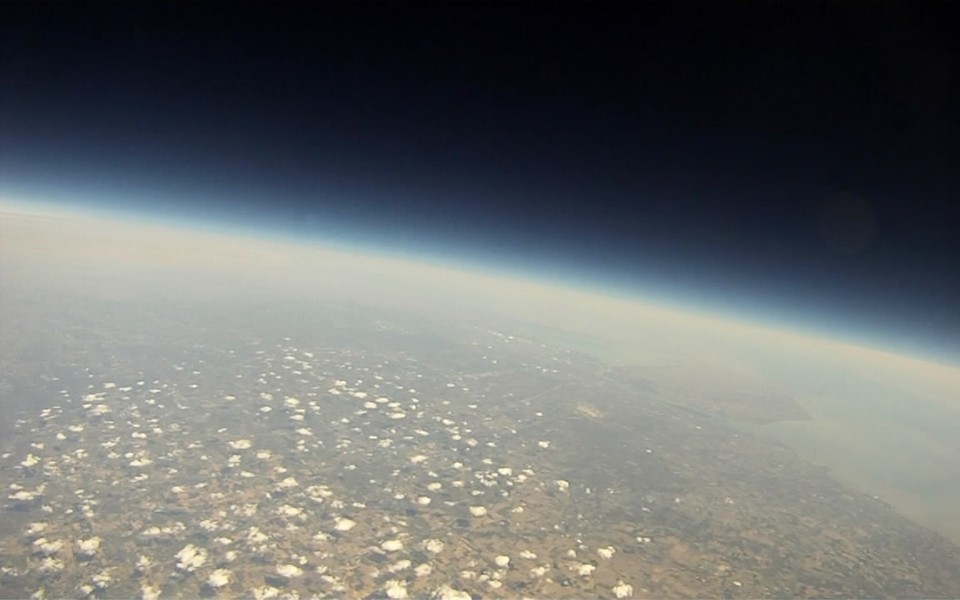New High-Altitude Weather Balloon Program at EMU selected to participate in nationwide eclipse balloon project supported by NASA

YPSILANTI – A new high-altitude weather balloon (HAB) program at Eastern Michigan University has recently been selected to participate in the NASA-funded and Montana State University-led Nationwide Eclipse Balloon Project (NEBP). This effort will broaden the participation of STEM learners by immersing teams from a wide range of higher education institutions in an innovative NASA-mission-like adventure in data acquisition and analysis through scientific ballooning during the 2023 annular and 2024 total solar eclipses.
The HAB program, known as EMU Atmospheric Physics Exploration (EMU APEX), was created by EMU Physics Professor Dave Pawlowski, and EMU Professor and atmospheric scientist, Tom Kovacs, who teaches a general education course in weather and forecasting. The program was created as an opportunity to build a sense of community amongst EMU students who share a diverse set of backgrounds and identities and provide hands-on and interdisciplinary learning opportunities to EMU students.
“For several years, high altitude weather balloon launches were a part of my physics capstone course, offering students the unique chance to design and build payload systems (the structural system of a rocket) to explore the atmosphere,” said Pawlowski. “It had been a few years since I had offered this and after having a conversation with Professor Kovacs, we decided it would be a good opportunity to restart the program for students.”
Soon after the two professors spoke, Pawlowski learned of the nationwide NASA project.
“Based on the goals of the NEBP and our own goals for EMU APEX, we knew that this was the perfect opportunity to serve as the official kickoff for the EMU APEX program,” said Pawlowski.
The professors submitted a proposal on behalf of EMU APEX and were subsequently selected as one of the teams to participate alongside approximately 70 other teams from institutions like University of Michigan, Pennsylvania State University, University of Kentucky, Central Washington University and more.
The NEBP comprises of two learner-centered activity tracks – engineering and atmospheric science. The EMU APEX team will participate in the engineering track.
As part of the engineering track, EMU APEX will be provided with the equipment necessary to design, build and launch a set of high-altitude balloon payloads that include a Raspberry Pi streaming video system, two data collection units; the Pterodactyl and the RFD900, a flight termination system and an iridium tracking system. The EMU APEX team will also assemble a ground tracking station to track and receive data from their balloon in flight. Through participation in the project, students will learn all the fundamentals of high-altitude balloon science and engineering.
The EMU APEX team, which will include a total of 20 EMU students pulled from Pawlowski’s Physics capstone course and Special Topics in Physics course, and Kovacs’ Introduction to Weather and Forecasting course, will get to travel to the Southeast United States for the October 14, 2023, annular eclipse and either Ohio or Pennsylvania for the total eclipse on April 8, 2024, with their innovations.
According to the NEBP website, during the eclipses, at sites along the eclipse path, EMU APEX and other student teams in the engineering track will use their larger balloon systems to live stream video to the NASA eclipse website, observe in situ perturbations in atmospheric phenomena, and conduct individually designed experiments. Team balloons will reach between 75,000 and 120,000 feet in altitude, where they will float during the eclipses, collect data, and stream video of the eclipses back to the ground. The data collected will be used to study atmospheric energetics and dynamics changes during the two solar eclipse events.
“This is an exciting and valuable opportunity for our students,” said Pawlowski. “Not only are they going to be gaining real-life, hands-on experience that will be incredibly helpful in their studies and future careers, they will have the opportunity to connect and collaborate with students and researchers from a variety of institutions around the country and not only be exposed to different ways of thinking but gain access to a number of training opportunities and resources that are being provided as part of the program.”
Following the NEBP, Pawlowski said the plan is for EMU APEX to become a student-led club open to all EMU students.
“As part of the club, EMU students could learn all about launching balloons and actually launch their own balloons.”
To learn more about the NEBP, visit the project’s homepage.
About Eastern Michigan University
Founded in 1849, Eastern is the second oldest public university in Michigan. It currently serves more than 14,000 students pursuing undergraduate, graduate, specialist, doctoral and certificate degrees in the arts, sciences and professions. In all, more than 300 majors, minors and concentrations are delivered through the University's Colleges of Arts and Sciences; Business; Education; Engineering and Technology; Health and Human Services; and its graduate school. National publications regularly recognize EMU for its excellence, diversity, and commitment to applied education. Visit the University’s rankings and points of pride websites to learn more. For more information about Eastern Michigan University, visit the University's website. To stay up to date on University news, activities and announcements, visit EMU Today.
January 25, 2023
Written by:
Morgan Mark
Media Contact:
Melissa Thrasher
mthrashe@emich.edu
734-487-4401
More Stories

EMU Honors Crochet and Knitting Club ties the community together through acts of service.

Southeast Michigan Stewardship Coalition at Eastern Michigan University appoints new leadership.




